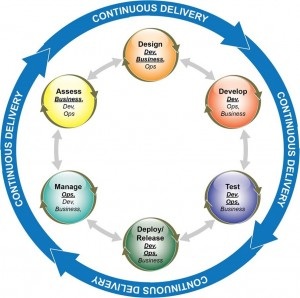LambdaTest announced its partnership with Assembla, a cloud-based platform for version control and project management.
A recent Enterprise Management Associates (EMA) blog, Best Practices for Innovating Through Cloud Technologies(link is external), discusses the results of EMA’s 2014 research on open cloud orchestration. It examines the pros and cons of a variety of cloud form factors and the business benefits of cloud computing in general.
EMA has also done a great deal of research on the topics of DevOps and Continuous Delivery, conducting major surveys on these topics in both 2014 and 2015. Cloud computing resources, like any other on-premise or off-premise hosted infrastructure, are, from the software perspective, in place for only one reason — they are platforms enabling the delivery of high-quality software and applications to facilitate business and customer interactions.
The DevOps movement can be viewed as building on IT Service Management (ITSM) as a set of informal best practices specifically addressing the collaboration necessary to support the heterogeneity of the software and infrastructure underlying modern applications. EMA analysts view DevOps practices as “the ideal intersection of people, processes, and tools required across the application lifecycle to facilitate the seamless delivery of applications supporting business objectives.” The emphasis is on the word “lifecycle” since both tools and collaboration are required at each stage, and continuity across the various stages is essential.
Today’s applications are massively distributed and componentized and require diverse elements — networks, databases, servers, storage, and often cloud infrastructure — to execute. Supporting these complex ecosystems requires cross-functional skills and collaborations that have now been institutionalized as dedicated teams in almost 60% of companies. It also requires tools capable of bridging silos and providing a common language that allows diverse teams to collaborate.
EMA sees DevOps as a fundamental skill supporting business flexibility and agility. The results of EMA’s latest survey on the topic (Automating for Digital Transformation: Tools-Driven DevOps and Continuous Software Delivery), conducted in October 2015, support this statement. Companies rating the interactions between Dev and Ops as “Above Average” or “Excellent” are 11.5 times more likely to achieve double-digit revenue growth than those rating such interactions as “Average” or “Poor.”
Why is this the case? EMA also sees DevOps practices as a framework for Continuous Delivery, which is another hot topic at the moment (see Figure 1). The term itself can be misleading, as “Continuous Delivery” means different things in different contexts. At its most generic, Continuous Delivery encompasses an iterative and ongoing cycle of development, testing, and delivery of software to a targeted destination. The destination could be a production environment or a software product package. Regardless of the target, the goal is to accelerate the delivery of software functions and capabilities. The value to the business is that good ideas can be put into practice as new software products or features much faster than was possible in the past with traditional lifecycle methodologies.
From this perspective, DevOps and Continuous Delivery are intimately intertwined, both with one another and with revenue growth. In effect, applying DevOps principles across the lifecycle smoothes the way or “greases the wheels” for efficient delivery of application code.

Figure 1. DevOps as a Framework for Continuous Delivery
Julie Craig is Research Director for Application Management at Enterprise Management Associates (EMA).
Industry News
Salt Security unveiled Salt Illuminate, a platform that redefines how organizations adopt API security.
Workday announced a new unified, AI developer toolset to bring the power of Workday Illuminate directly into the hands of customer and partner developers, enabling them to easily customize and connect AI apps and agents on the Workday platform.
Pegasystems introduced Pega Agentic Process Fabric™, a service that orchestrates all AI agents and systems across an open agentic network for more reliable and accurate automation.
Fivetran announced that its Connector SDK now supports custom connectors for any data source.
Copado announced that Copado Robotic Testing is available in AWS Marketplace, a digital catalog with thousands of software listings from independent software vendors that make it easy to find, test, buy, and deploy software that runs on Amazon Web Services (AWS).
Check Point® Software Technologies Ltd.(link is external) announced major advancements to its family of Quantum Force Security Gateways(link is external).
Sauce Labs announced the general availability of iOS 18 testing on its Virtual Device Cloud (VDC).
Infragistics announced the launch of Infragistics Ultimate 25.1, the company's flagship UX and UI product.
CIQ announced the creation of its Open Source Program Office (OSPO).
Check Point® Software Technologies Ltd.(link is external) announced the launch of its next generation Quantum(link is external) Smart-1 Management Appliances, delivering 2X increase in managed gateways and up to 70% higher log rate, with AI-powered security tools designed to meet the demands of hybrid enterprises.
Salesforce and Informatica have entered into an agreement for Salesforce to acquire Informatica.
Red Hat and Google Cloud announced an expanded collaboration to advance AI for enterprise applications by uniting Red Hat’s open source technologies with Google Cloud’s purpose-built infrastructure and Google’s family of open models, Gemma.
Mirantis announced Mirantis k0rdent Enterprise and Mirantis k0rdent Virtualization, unifying infrastructure for AI, containerized, and VM-based workloads through a Kubernetes-native model, streamlining operations for high-performance AI pipelines, modern microservices, and legacy applications alike.
Snyk launched the Snyk AI Trust Platform, an AI-native agentic platform specifically built to secure and govern software development in the AI Era.




